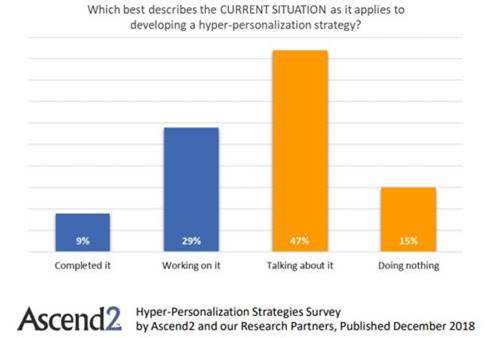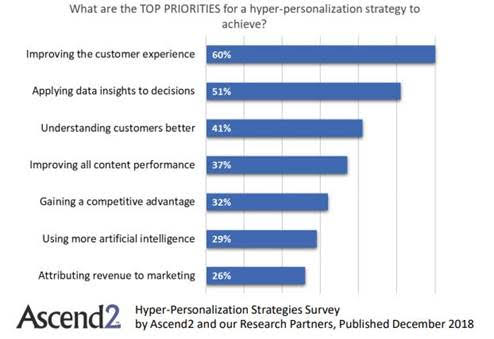As a shopper, I’ve always appreciated being able to find exactly what I’m looking for. Whether it’s the perfect pair of jeans or a gift for a friend, it takes the guesswork out of shopping when retailers offer hyper customization. And as someone who loves to shop, I can say that the hyper customization trend is changing the future of retail in a very exciting way!
Hyper Customization
The ability to customize or tailor something to an excessive or extreme degree.
What is hyper-personalization?
Using AI and real-time information, hyper-personalization is a marketing strategy that tailors each message to each user.
But what will personalization practices be in 2022?
The 2021 report, “Hyper-personalized Marketing: The Next Frontier,” answers questions about what marketers can expect from personalization in 2022. 143 respondents fielded the report during the week of Nov. 26, 2021.
Here are a few of the survey results and ways you can use the information to improve your business.
1. Hyper-Customization Strategy – Beat Your Competition
Only 9% of businesses have developed their personalized marketing strategies. These are the early adopters.
The majority of marketers, 62%, are just talking about or haven’t implemented a personalization strategy for their marketing. If you implement one now, you will be ahead of your competitors.
You’ll never see a different view if you’re not in the lead. So be the leader and create your personalization strategy for your company. This will allow you to stand out from your competition and provide a unique experience for your clients.
2. Top Customer Preferences for Hyper-Personalization
Improving the customer experience personalization is a high priority for 60% of marketing professionals. Any time you can streamline the process, you will reap the benefits.
As you gather more information about your customers, take time to analyze it. Use that information to customize your marketing for each customer, and you’ll see your marketing efforts pay off.
As you create a personalized strategy, remember your priorities. Ask yourself if your plan stays in line with your priorities and make adjustments as needed.
Don’t implement cool technologies because they’re “new” or “innovative.” Make sure they help you accomplish your most important goals.
3. Hyper-Personalization Strategy – The Most Effective Applications for Hyper-Personalization Strategy
The AI tools that are most effective in a personalization strategy are predictive analysis, UX, and curation.
Review the statistics below and determine which method works best for you.
Suppose your company uses a lot of marketing tactics that involve content creation. In that case, you might want to consider using a tool that uses AI machine learning to personalize the content that you create. Using this type of technology, you can personalize the content created for each person based on their interests and preferences. This level of customization can be very effective when it comes to customer engagement, and it can also boost conversions.
Customer Hyper-Personalization – Three Ingredients Lead to Effective Customer Hyper-Personalization
Most brands are already doing personalized or custom experiences with customers, and going further with personalization may not be a huge leap.
It’s not just about having a strategy, it’s about turning that into an amazing customer experience that customers love. It’s all about delighting and impacting them.
Three key ingredients lead to successful personalization.
Personalization Strategy – How to Personalize Your Customer Experience
Consumers expect personalized experiences from companies extending into the digital space. For instance, if companies like Netflix and Spotify can tailor their offerings to each user, other firms should be able to do so.
What makes your brand unique? How can you use that to create a personalized customer experience? Your brand has a unique voice, and you can use that to create a more personal customer experience. Whether it’s through the content you create or how you engage customers in conversation, make sure your brand’s personality shines through.
Using customer information, such as their shopping and purchase history, you can offer them personal deals on their phone calls.
Are you worried about keeping data consistent between a digital and a voice experience? Try offering a call scheduler to collect customer information when they transition from one to the other.
Getting Relevant With Your Customer Data
To create customized, relevant experiences, you need to know your customers.
Being relevant to your prospects is tricky, but you can become highly relevant with the right (or adequate) amount of data.
If you’re looking to stand out, context is king. But in a data drought, don’t rely only on segmenting customers by demographics, as this can soon become stale for customers who identify differently. Instead, look at the big picture.
The key to leveraging data is to look at multiple contexts, not just one. For example, you can’t just rely on past purchases.
Take a look at how they have engaged with you online. Figure out what their goals are.
Then, use other data about other segments of your customer base to hone in on something relevant and timely.
Build Trust in Your Customer Experiences
It can be a little strange, but tracking can be extremely helpful. 85% of customers prefer to control what information companies learn about them, but 65% of people have come to terms with the fact that they have no say in the matter.
You don’t want to make customers feel obligated to give up their personal information to your company.
You can build customer trust by ensuring that your agents are showing empathy for your customers. Give them the option of interacting with a human, and then train your reps to be empathic, so they’ll be able to listen and respond appropriately. By doing this, you’ll appear more trustworthy, which will make your customers want to focus on the experience itself (instead of the data).
The more you can personalize and humanize your interactions, the more people will be focused on seeing (and less on using) their data.
Benefits of Hyper-Personalization
One of the benefits of hyper-personalization is that you can offer your customers extremely customized experiences. To do this, you need to have real-time insight into the customer journey to know what your customer is looking for at any given moment.
Real-time analytics will help teams better understand their customers, which will help them personalize the customer journey, develop better products, and market more effectively.
Another benefit of hyper-personalization is that it can lead to increased revenue. When customers are given offers or experiences unique to them, they are more likely to find a solution to their problems. This, in turn, can lead to more sales and more satisfied customers.
This could take the form of a new product or simply solving a problem with an existing product. Either way, this will build brand loyalty and keep customers coming back. And when they come back, their customer lifetime value is increased.
When customers come back, they’re happy with what they’ve purchased. And when they’re happy, they’re more likely to continue doing business with you. This increases their customer lifetime value (CLV).
When you invest in hyper-personalization, your channels become more connected, and you can attribute revenue more accurately. This isn’t easy to do across experiences today, but it’s worth the investment.
Conclusion
As hyper customization becomes more and more common in retail, shoppers can expect to see even more personalized shopping experiences. This trend is already changing the way we shop, and it’s only going to become more prevalent in the years to come. So whether you’re looking for that perfect pair of jeans or a unique gift for a friend, keep an eye out for retailers offering hyper customization – it just might be exactly what you’re looking for!
Request a Data License and Access the World's People + Company Data
Want 300 million+ profiles at your fingertips? Updated monthly with the data on your own server/host!
Including personal emails, business emails, mobile numbers, mailing addresses and more.
You get net worth, ages, company data, and more.
Use it for cold outreach, paid ad campaigns, direct mail, social selling or even cold calling.
Use it with unlimited access for your own app, outreach campaigns, or as a client service.
Oh, and did I mention we can identify individuals visiting your, or your client's, website?
Contact us for how you can access the entire dataset, on your own server. No more API limits, no price per contact.
[/scWant to help contribute to future articles? Have data-backed and tactical advice to share? I’d love to hear from you!
We have over 60,000 monthly readers that would love to see it! Contact us and let's discuss your ideas!


